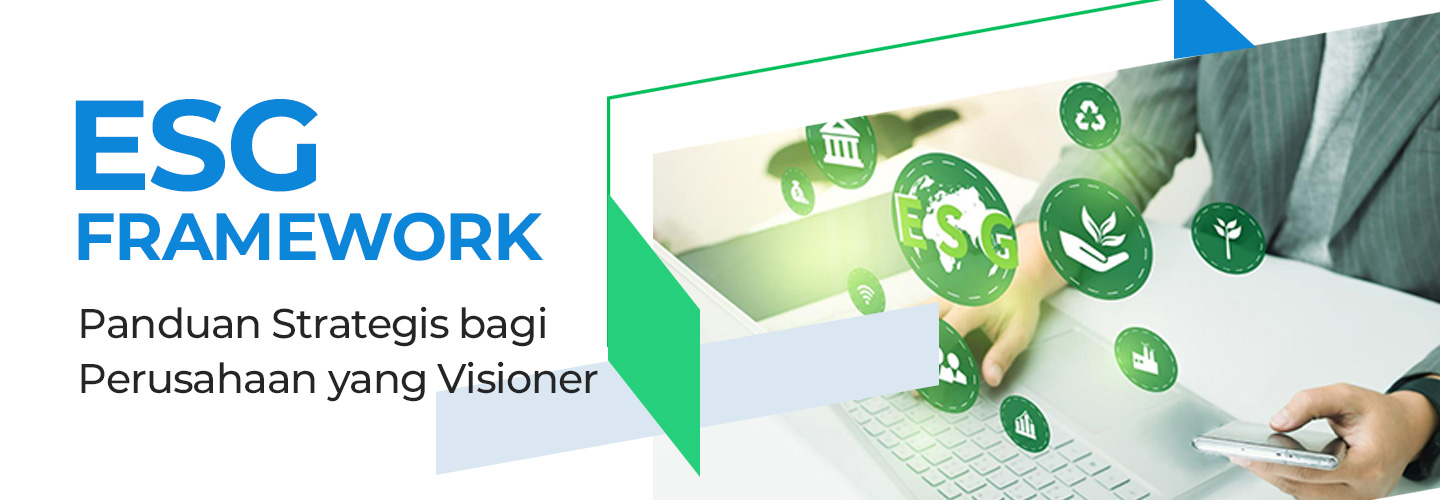What is ESG? A Framework for Identifying and Mitigating Business Risks

ESG (Environmental Social, and Governance) has become quite popular in corporate operations since 2005, surpassing the popularity of the term CSR (corporate social responsibility).
Many businesses and companies implement ESG in the implementation of their business practices and as part of the company's goals.
This is evident from the Sustainability reporting in focus from the G&A Institute in 2021 which stated that more than 90% of companies listed on the S&P 500 (Standard & Poor's 500) stock exchange in the United States have published ESG reports in various formats.
Post COVID-19, an observation conducted by the Center for Corporate Reputation Oxford University, found that when the stock market collapsed, companies on the Nasdaq that had a strong ESG implementation track record could outperform companies with a low ESG track record.
Implementing ESG in business is no longer just following trends, but as a social responsibility, concern for the environment, and conservation of natural resources.
Today's business world cannot only focus on pursuing finances alone. It is necessary to balance environmental and social aspects with the profit goals being pursued.
By understanding ESG, companies not only balance their business processes but are also able to identify and mitigate business risks.
Therefore, this article will discuss what ESG is and how ESG plays a role in mitigating business risks.
What is ESG?
Environmental Social and Governance (ESG) is a business framework used as a parameter in company operations that focuses on environmental and social impacts.
ESG is closely related to sustainability and long-term business. The issue of sustainability is a concern for many parties. Focusing on sustainability values is not just an option but has become essential for business.
In Indonesia itself, the OJK has released a regulatory mandate for private companies, companies registered in Indonesia, and financial companies to submit sustainability reports through OJK Regulation Number 51/POJK.03/2017.
What are the Main Components of ESG?
ESG has three main components that are useful for measuring the sustainability, social impact and governance aspects of a company.
The three main components of ESG are environmental, social, and governance
The right implementation of ESG can drive company performance which leads to increased company profits and risk mitigation.
The following are the three main components of ESG
Environmental
Focuses on how a company's operations impact the environment. This includes issues such as carbon emission management, renewable energy use, natural resource sustainability, waste management, and other impacts on the ecosystem.
Social
This social component measures how a company treats its social stakeholders. This includes human rights, working conditions, community engagement, diversity and inclusion, and the company's relationship with consumers and the community.
Governance.
Focuses on how the company is managed and supervised. This includes transparency in decision-making, leadership structure, risk management, minority shareholder protection, and ethics in conducting business.
As attention to sustainability and responsible investment increases, ESG has become an increasingly important factor in investment decision-making and business strategies around the world.
What are the indicators of ESG?
What are the indicators to measure the success of ESG implementation? The following indicators are provisions for planning a sustainable business.
The following are ESG indicators that companies often apply.
1. Environmental Indicators
Environmental indicators include how operational impacts from upstream to downstream impact the environment. The indicators include the following:
- Management of greenhouse gas emissions.
- Climate change mitigation strategies.
- Efficient use of energy, water, and raw materials and waste reduction.
- The impact of company operations on ecosystems and biodiversity.
2. Social Indicators
The indicators measured in the social aspect are not only human resources within the company, but also external to the company. The following are social indicators that can be parameters:
- Interaction with the community, customers, and the wider community.
- Working conditions, safety, work-life balance, and employee satisfaction.
- Efforts to create an inclusive and diverse work environment.
- Participation in social activities and contribution to community welfare.
3. Governance Indicators
Transparent and effective governance is a parameter for company operations that have a positive impact. Here are some indicators related to organizational governance:
- Transparency in reporting and decision-making.
- Board of directors composition, independence, and diversity.
- Compliance with laws, regulations, and ethical standards.
- Identification, assessment, and mitigation of risks faced by the company.
What are the Benefits of ESG for Companies?
Investing in implementing ESG (Environmental, Social, and Governance) in a company is not only about meeting social and regulatory demands, but also a strategic step that can improve financial performance and long-term competitiveness.
Here are some of the benefits that companies can get by implementing ESG:
- Improved financial performance and risk reduction.
- Increased revenue growth.
- Cost reduction.
- Increase positive impact on stock performance.
- Minimization of regulatory and legal intervention.
- Increased employee productivity.
- Optimization of investment and capital expenditure.
- Investor preference for businesses with a positive ESG reputation.
How can ESG mitigate business risks?
ESG can help companies identify and manage risks related to external factors that may not be reflected in traditional financial analysis.
In a McKinsey interview with a former UPS CFO, he stated that adopting frameworks such as the Sustainability Accounting Standards Board (SASB) helps companies measure, manage, and disclose material ESG risks. This allows companies to identify potential risks early and take appropriate mitigation steps.
By engaging ESG principles, companies can mitigate potential risks from:
1. Environmental Risks
Climate change, stricter environmental regulations, and potential ecosystem damage can threaten a company’s operations. Companies that are proactive in reducing carbon emissions and adopting environmentally friendly business practices can be better prepared to face these challenges and mitigate risks related to reputational damage and legal compliance.
2. Social Risks
Social issues such as labor inequity, human rights, and diversity within a company can pose litigation or reputational risks. Integrating social principles into ESG, such as ensuring a fair and diverse work environment, helps mitigate potential social conflicts or customer and employee dissatisfaction.
3. Governance Risks
Poor governance practices, such as a lack of transparency and oversight, can increase the risk of fraud, corruption, or poor decision-making. Companies that implement strong and transparent governance principles are more resilient to legal and reputational risks that can arise from mismanagement.
By actively managing and mitigating ESG risks, companies not only improve their resilience to external issues but also create opportunities for long-term growth.
What are the Benefits of ESG in Risk Management?
Effective risk management through the implementation of ESG offers a variety of direct and indirect benefits to companies, including:
- Reduced Financial Risk caused by environmental disasters, social litigation, or governance crises.
- Increased resilience to crises, whether economic, social, or environmental.
- Reduced market uncertainty so that companies can better respond to changing market dynamics.
- Increased investor, consumer, and stakeholder confidence.
How to Integrate ESG in the risk management process?
Integrating ESG in risk management involves several strategic steps, such as the following:
1. Identify Your Company's Material ESG Issues
Identify ESG issues that are relevant and material to your company. These material issues are factors that have a significant impact on the company's performance and can influence stakeholder decisions (investors, consumers, regulators, etc.).
Some things to consider in identifying material ESG issues include:
- Environmental issues such as carbon emissions, waste management, and use of natural resources.
- Social issues such as human rights, diversity, labor conditions, and community engagement.
- Governance issues such as transparency of company management, board of directors oversight, and anti-corruption policies.
2. Audit Your Company's ESG Risk
After identifying material issues, the next step is to assess the potential ESG risks that could affect the company. This is a very important step to understand the potential impacts of each identified ESG issue.
Through this risk assessment, companies can understand the impact and probability of risks that may arise from existing ESG issues, as well as how to assess how much they will affect the company's sustainability and reputation.
3. Develop Your Business Risk Mitigation Strategy
After assessing ESG risks, the next step is to develop a strategy to reduce or avoid these risks. This mitigation strategy should include concrete steps that the company can take to reduce the negative impacts of the identified ESG issues.
This strategy should be aligned with the company’s business priorities and may involve changes in operational processes, internal policies, and training for employees and management.
4. Monitor and Report Your Company’s ESG Progress
The final step is to monitor and report on the progress of ESG implementation in risk mitigation. This is important to ensure that the company remains on track in its ESG risk mitigation efforts and to be able to evaluate how effective the strategies implemented are.
This monitoring and reporting process will also help companies make further adjustments to the mitigation strategies that have been implemented if necessary.
List of Companies that Successfully Implement ESG based on LSEG
In 2024, the London Stock Exchange Group (LSEG) released a list of 50 Indonesian companies with the best ESG scores.
The assessment was carried out with a combination of qualitative and quantitative to maintain data accuracy and consistency.
On a scale of 1-100, here are the ESG scores obtained by 10 large Indonesian companies that are included in the list of 50 Indonesian companies with the best ESG scores:
- PT Bank Rakyat Indonesia Tbk (BBRI), ESG Score: 86
- PT Indo Tambangraya Megah Tbk (ITMG), ESG Score: 85
- PT Bumi Resources Tbk (BUMI), ESG Score: 85
- PT Bank Negara Indonesia Tbk (BBNI), ESG Score: 83
- PT Bank Mandiri Tbk (BMRI), ESG Score: 83
- PT Bank Central Asia Tbk (BBCA), ESG Score: 79
- PT Bukit Asam Tbk (PTBA), ESG Score: 80
- PT Vale Indonesia Tbk (INCO), ESG Score: 78
- PT Unilever Indonesia Tbk (UNVR), ESG Score: 80
- PT Semen Indonesia Tbk (SMGR), ESG Score: 71
- PT Kalbe Farma Tbk (KLBF), ESG Score: 68
- PT Surya Citra Media Tbk (SCMA), ESG Score: 66
Mitigating Your Business Risk with ESG Implementation
Risk management is not only based on financial reports. However, now it can be seen from ESG parameters. So that the visible business risk can be even broader.
By being able to identify and mitigate business risks, this prevents deeper losses. It can even identify opportunities that exist from each risk.
Companies that manage ESG risks well can increase their resilience to crises, gain competitive advantages, and attract more investors and customers who care about sustainability.
Has your company started integrating ESG into its business strategy?
The ESG in Action Workshop: From Plan to Impact from Prasmul-Eli can be the main foundation for aligning understanding about the implementation of ESG in business strategy.
Let's mitigate business risks for better opportunities.
